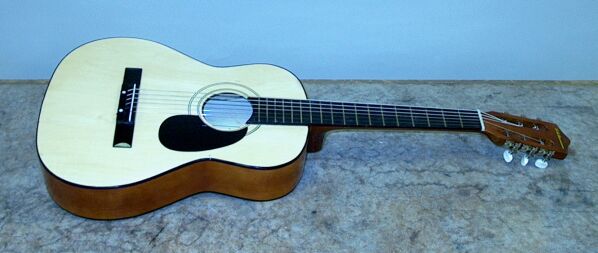

With the guitar, you can illustrate the behavior of a vibrating string. Plucking the string while you place a finger on it near different frets shows how the pitch of the vibration changes with the length of the string. Turning a string’s tuning peg (while plucking it) shows how changing the tension affects the pitch. By gently placing a finger so as to divide the string into integral portions (i.e., 1/2, 1/3, 1/4, etc.), and then plucking the string, you can show the excitation of various harmonics above the fundamental. You can also show how the location at which you pluck the string affects the harmonic content of the vibration. (Relative to the sound you get when you pluck near the sound hole, plucking over the fingerboard gives a sound that has less intensity in the higher harmonics, and which is thus mellower. Plucking near the bridge produces a tone in which the upper harmonics are more intense than the lower harmonics, which is thus brighter.)
The guitar is a six-stringed instrument, whose body has curved sides, a flat top and a flat back. Its fingerboard is also flat, and is fretted. That is, it has thin metal strips embedded in its surface. When the player presses down on a string just above one of these frets, it stops the string at a well-defined location. The frets are placed so that the amount by which each successive fret changes the length of the string corresponds to an interval of a half step (minor second). That is, if you are pressing the string down at a particular fret, pressing at the one above it (towards the head, where the tuning pegs are) lowers the pitch by a half step, and pressing at the one below it (towards the body) raises the pitch by a half step. The piece on which the strings sit at the head of the guitar, is called a “nut.” The strings are anchored on the other side of the sound hole, at the bridge, where they go over a piece called a “saddle,” and where they are either tied, or anchored by pins. The nut and the saddle together determine the length of the open string.
The strings on the guitar are tuned, from lowest to highest, to the pitches E, A, d, g, b, e′, where E is the E an octave-and-a-minor-sixth below middle C (the E one line below the bass-clef staff). The pitches go up in perfect fourths, until the b a major third above the g, then again a perfect fourth from b to the e′ at the top, two octaves above the lowest string (a major third above middle C). The A is the one at 110 Hz. (Guitar music is notated in treble clef. The instrument sounds an octave below the notated pitches.)
As noted above, you can illustrate the relationship between string length and vibrational frequency, by pressing down near different frets and plucking the string on which you are pressing. You can also change the tension of a string by turning its tuning peg, and show how this affects the pitch of the string.
If you press lightly at a point that divides the string into some integral number of pieces (i.e., you place your finger at a distance from the nut that is equal to exactly 1/2, 1/3, 1/4, etc., the length of the string), and pluck near the sound hole (exactly where will probably depend on the harmonic you are trying to excite), you can sound various harmonics.
Also as noted, you can show how plucking at different points on the string – near the sound hole, over the fretboard or near the bridge – affects the balance of the harmonics in the tone that you produce by doing so.